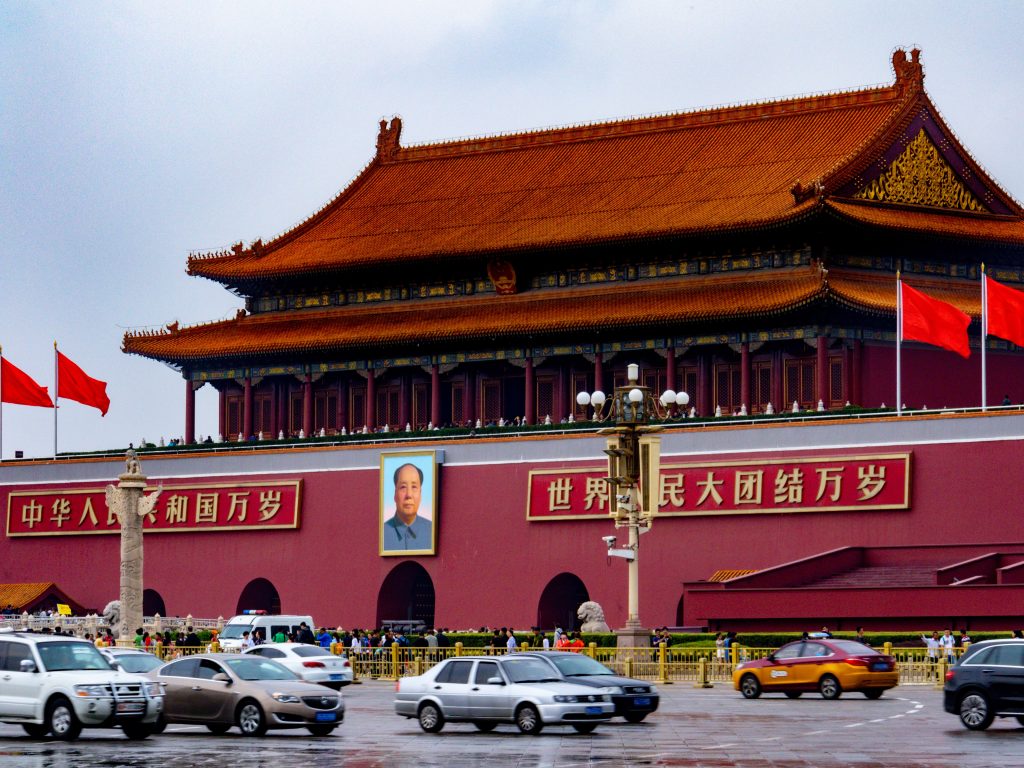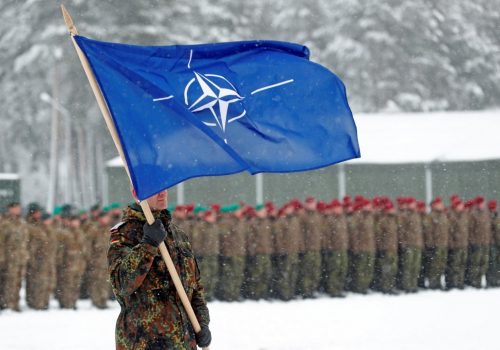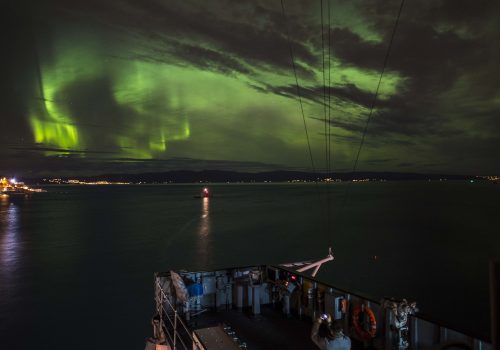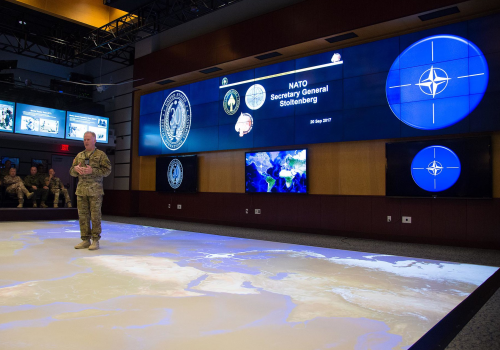Build an Atlantic-Pacific Partnership
The West is recognizing that China’s rise has fundamentally shifted the global balance of power. For the first time, the European Union (EU) declared China as a “systemic rival” in 2019.1High Representative of the Union for Foreign Affairs and Security Policy, EU-China – A strategic outlook, European Commission, 2019, https://ec.europa.eu/commission/sites/beta-political/files/communication-eu-china-a-strategic-outlook.pdf NATO leaders also mentioned China for the first time in the 2019 London Declaration, identifying both the “opportunities and challenges” of China’s growing influence.2NATO heads of State and Government, “London Declaration,” North Atlantic Treaty Organization, December 4, 2019, https://www.nato.int/cps/en/natohq/official_texts_171584.htm As the West grapples with a strategy to address China’s rise, it faces a full-spectrum challenge from China in traditional and non-traditional security spheres that NATO is best positioned to confront.
In the traditional security sphere, China has continued its aggressive actions in the South China Sea while expanding its naval power beyond the waters of Asia to the Indian Ocean, the Mediterranean, the North Atlantic, and the Arctic. This activity is accompanied by an increasingly global military footprint—including the development of overseas bases and strategic seaports. Such actions and their potential consequences pose an increasing threat to the maritime security of NATO allies, as well as their access to global seaborne trade. Beijing’s growing military cooperation with Moscow in both the Asian and European theaters also complicates allied contingency planning by raising the possibility of a coordinated horizontal escalation.
In the non-traditional sphere, Europe will face a particularly acute challenge from the Chinese Communist Party’s (CCP) global influence operations. While the CCP’s efforts to shape the global information environment came to the fore in Europe at the outset of the COVID-19 outbreak, it has long engaged in more malign and surreptitious forms of influence operations. These include cyber warfare and espionage, dis- and misinformation campaigns, election interference, co-opting independent media, and bribing public officials.
Europe is not alone in facing this challenge from China. Much like the individual countries of Europe, not all Indo-Pacific states are equipped to counter traditional and non-traditional security threats from Beijing. In order to protect their economic freedom, democratic institutions, and national security, transatlantic and Indo-Pacific states share the common task of responding to China’s rise. The international community needs a credible, multilateral champion that can form an “Atlantic-Pacific Partnership” and serve as a strategic counterweight to Beijing’s growing military assertiveness, whether it’s in the South China Sea, the European theater, or the Arctic. Given its institutional structure, capabilities, and capacity to link Indo-Pacific partners under a cohesive multilateral mechanism, NATO is the institution best suited to take on this role.
In the coming decade, NATO should establish itself as the central node of a global network dedicated to countering China’s hostile and malign activities by formalizing an Atlantic-Pacific Partnership (APP). This effort should first be focused on integrating NATO’s existing bilateral relationships with Australia, Japan, South Korea, and New Zealand into a multilateral “30+4” consultative network, while still seeking other opportunities for collaboration in the region and beyond. As it develops, the habits of cooperation built through the APP would create a foundation for coordinated planning and response to China’s traditional and non-traditional threats in Europe and Asia. NATO should lead this effort for several reasons:
Watch the video
Structural resilience to Chinese pressure
First, as an institution focused on security, NATO is uniquely resilient to Chinese pressure in ways other organizations are not. A notable example is the Association of Southeast Asian Nations (ASEAN), a major regional multilateral institution whose members’ economic dependence on, and geographic proximity to, China provide it deep incentives to avoid confrontation.3Ayman Falak Medina, “ASEAN Overtakes EU to Become China’s Top Trading Partner in Q1 2020,” ASEAN Briefing, https://www.aseanbriefing.com/news/asean-overtakes-eu-become-chinas-top-trading-partner-q1-2020/ Furthermore, primarily due to the historical development of the region, security in the Indo-Pacific is characterized by a web of disjointed security groupings and bilateral alliances. As China grows increasingly assertive, this lack of a unifying, credible, multilateral enforcer in the region will become a major challenge.
NATO’s credibility in this context lies in its multilateralism and diversity. Compared to a unilateral US-led response to Chinese aggression, a NATO-led, and therefore consensus US-European response, would have global legitimacy in the eyes of many. At the same time, leadership from a US-led multilateral organization like NATO would reassure US allies and partners in the Indo-Pacific that the United States remains committed to a coordinated effort among democracies.
Existing capabilities to counter traditional and non-traditional security threats
NATO has existing capabilities to counter traditional and non-traditional security threats. In the realm of traditional security, not only does NATO have the military capacity to uphold maritime security in regions beyond Europe, but it has also proactively supported and participated in military operations concerning global security. NATO has led the International Security Assistance Force in Afghanistan (now the Resolute Support Mission) and provided training to national militaries in the Middle East as a member of the Coalition to Defeat the Islamic State of Iraq and al-Sham (ISIS). Since 2008, its naval forces have also actively conducted anti-piracy operations off the shores of Africa.
Further, NATO allies like the United Kingdom and France have individually stepped up their presence in the Indo-Pacific. The United Kingdom conducted its first joint exercise with the United States in the South China Sea in 2019 and deployed the HMS Albion to conduct Freedom of Navigation (FON) exercises near the Paracel islands in August 2018.4“British navy’s HMS Albion warned over South China Sea ‘provocation,’” BBC, September 6, 2018, https://www.bbc.com/news/uk-45433153 At the Shangri-La Dialogue in 2018, French and British defense ministers announced they would sail warships through the South China Sea to challenge China‘s military expansion.5Liu Zhen, “France, Britain to sail warships in contested South China Sea to challenge Beijing,” South China Morning Post, June 4, 2018, https://www.scmp.com/news/china/diplomacy-defence/article/2149062/france-britain-sail-warships-contested-south-china-sea As the leading member of NATO, the United States has spearheaded many of NATO’s global military operations and continues to work with its allies in Asia to counter China’s maritime expansion in the Indo-Pacific. The administration of US President Donald J. Trump has pursued measures to deepen security cooperation with allies and partners with stakes in the South China Sea. For example, the United States has provided over $300 million through the US Department of State’s Southeast Asia Maritime Security Initiative, and conducted a record number of Freedom of Navigation Operations (FONOPS) in the South China Sea in 2019.6The US Coast Guard engages in robust capacity building training efforts and equipment transfers to Southeast Asian nations as well. “A Free and Open Indo-Pacific: Advancing a Shared Vision,” US Department of State, November 4, 2019, https://www.state.gov/wp-content/uploads/2019/11/Free-and-Open-Indo-Pacific-4Nov2019.pdf Amy E. Searight, “US Coast Guard cooperation with Southeast Asia: Maritime Challenges and Strategic Opportunities,” Statement before the US House of Representatives Committee on Transportation and Infrastructure, March 10, 2020, https://transportation.house.gov/imo/media/doc/Searight%20Testimony.pdf NATO’s largest allies are clearly cognizant of, and willing to address, China’s military threat.
Further, NATO allies like the United Kingdom and France have individually stepped up their presence in the Indo-Pacific.
In the sphere of non-traditional security, NATO allies have experience working together to counter Russian gray-zone threats, including influence operations. At the NATO Foreign Ministerial meeting in 2015, NATO adopted a strategy to counter hybrid threats in cooperation with the European Union. Member-states were encouraged to map potential vulnerabilities borne out of Russia’s involvement in their “business, financial, media, or energy concerns,” and share lessons learned within NATO.7Brittany Beaulieu and David Salvo, “NATO and Asymmetric Threats: A Blueprint for Defense and Deterrence,” German Marshall Fund: Alliance for Security Democracy 31 (2018): 3, https://www.jstor.org/stable/resrep18856?seq=1#metadata_info_tab_contents Jamie Shea, “Resilience: a core element of collective defence,” NATO Review, March 30, 2016, https://www.nato.int/docu/review/articles/2016/03/30/resilience-a-core-element-of-collective-defence/index.html More recently, in response to Russia’s dissemination of disinformation related to the COVID-19 pandemic, NATO has intensified digital communications across all platforms, hosting online events and producing articles, translating factsheets, and broadcasting videos (even in Russian) to counter false narratives.8“NATO’s approach to countering disinformation: a focus on COVID-19,” North Atlantic Treaty Organization, last updated July 17, 2020, https://www.nato.int/cps/en/natohq/177273.htm#case NATO also stepped up engagement with the European Union, G7, United Nations, and the US Department of State to organize a coordinated response to mitigate Russian disinformation.9Ibid.
Although the strategy and tactics of Russian and Chinese influence operations differ, and NATO’s track record of responding to influence operations is varied, this experience and existing response mechanisms provide a framework for countering non-traditional threats from China. This makes NATO the ideal institution through which Atlantic states can partner with Indo-Pacific states, transfer institutional knowledge, rigorously investigate best practices through information sharing, and build resilience.
Mechanisms for enlisting allies and partners in the Indo-Pacific
NATO can leverage its existing institutional connections to coordinate key US allies and partners in the region. US allies in the Indo-Pacific, and their proximity to China, posits these nations as the first line of defense against Beijing’s aggression, a reality that makes them essential to any multilateral effort to maintain the rules-based international order. Additionally, NATO maintains six individual channels for engaging key Indo-Pacific nations as “global partners:” Japan, South Korea, Australia, New Zealand, Pakistan, and Mongolia. However, these partnerships operate primarily on a bilateral, siloed, and consultative basis, focusing on issue areas tailored to each country and each differing in the intensity and nature of partnership activities. Certain NATO member states also have partnerships with countries in the Indo-Pacific through mechanisms such as the Five Eyes, the Five Power Defense Agreement, the Quad, and several other strong but disparate bilateral security agreements.
A cohesive mechanism that connects these individual partnerships around a shared central threat does not yet exist. This presents a critical gap that NATO can bridge to unify and deepen these existing mechanisms. Individual Southeast Asian countries not involved in the previously listed arrangements may also be more amenable to joining a NATO-led initiative in the Indo-Pacific rather than a US-led one.10Amitav Acharya, “Why Is There No NATO In Asia?” The Normative Origins of Asian Multilateralism, (Harvard University, 2005, https://wcfia.harvard.edu/files/wcfia/files/1049_why_no_asian_nato_final.pdf
Policy recommendations
As NATO and its allies adapt to a more competitive, multipolar world, the Alliance and its leading members should advance the following priorities:
Establish an official Atlantic-Pacific Partnership that provides like-minded Indo-Pacific countries the opportunity to participate in a NATO-coordinated regional network. NATO should focus initial efforts on integrating its existing bilateral relationships with Australia, Japan, South Korea, and New Zealand into a multilateral “30+4” consultative network. The APP would provide opportunities for multilateral dialogue to address the most pressing challenges facing the transatlantic-pacific community. Modeled after NATO’s existing efforts with Finland and Sweden, security cooperation under the APP could include “regular political dialogue and consultations; exchanges of information on hybrid warfare; coordinating training and exercises; and developing better joint situational awareness to address common threats and develop joint actions, if needed.”11“Relations with Sweden,” North Atlantic Treaty Organization, July 15, 2020, https://www.nato.int/cps/en/natohq/topics_52535.htm

Modeled after NATO’s existing efforts with Finland and Sweden, security cooperation under the APP could include “regular political dialogue and consultations; exchanges of information on hybrid warfare; coordinating training and exercises; and developing better joint situational awareness to address common threats and develop joint actions, if needed.”
Tiananmen Square (source: Nick Fewings Unsplash)
Early cooperative efforts can leverage NATO’s strong track record on military cooperation to establish a regularized mechanism for discussing strategic issues and sharing intelligence on China’s maritime capabilities and activities in the South China Sea and Indian Ocean, joint military cooperation between China and Russia, and China’s overseas influence operations. These mechanisms could then be used as a platform to develop a collective Atlantic-Pacific security posture toward China or a coordination mechanism for responding to traditional and nontraditional security threats.
At the same time, seek opportunities to expand relations with ASEAN, while remaining realistic about the limitations on cooperation. Prior interactions by NATO allies with ASEAN member states have been limited to arms sales to specific countries that met international standards on human rights. In light of this history, early efforts could focus on expanding existing mechanisms such as the ASEAN+3 Defense Ministers Dialogue and deepening people-to-people ties through enhanced inter-governmental and inter-institutional exchanges. As it builds a relationship with ASEAN, NATO also could target outreach to key members who are likely to be more interested in proactively responding to Chinese security threats. Working alongside the Expanded ASEAN Maritime Forum (EAMF), NATO could assist in capacity building and equipment transfers to Southeast Asian states while respecting ASEAN’s opposition to external militarization of the region. Even if initial efforts do not count on strong institutional buy-in from ASEAN, it will be critical for NATO to maintain channels for building greater levels of support over the long-term, should ongoing geopolitical trends deepen the institution’s concerns about undue Chinese influence.
Combat non-traditional threats by expanding resilience. In a world where security threats increasingly come from non-traditional, non-military sources, focusing cooperation among NATO partners on conventional defense and security has proven insufficient. NATO must work within the APP to prepare societies for a wider range of threats. NATO’s seven baseline requirements for resilience currently emphasize support for continuity of government, the provision of essential services in NATO member states, and civil support to the military. Thus far these requirements have proven valuable in addressing certain vulnerabilities to Chinese influence, control, or espionage, particularly in 5G networks. However, they do not address the pervasiveness of Chinese influence operations in supply chains, society and politics, cyberspace, business, infrastructure development, and many other areas. NATO cannot be caught flat-footed in response to these challenges, which demand a different strategy.
The APP should be the forum through which a more expansive approach to resilience is explored. Using insights from Indo-Pacific countries that have faced more extensive Chinese influence efforts than Europe, these discussions should explore a new concept of resilience that would focus specifically on identifying, exposing, and countering a broad range of influence operations. This concept would expand the scope of resilience to account for activities not yet addressed by NATO, but routinely directed by the Chinese government against foreign states, including coercive diplomacy, meddling in elections, co-option of educational and cultural institutions, and industrial espionage.
Looking forward to the Alliance’s strategic operations in 2030, NATO Secretary General Jens Stoltenberg said, “we need to work even more closely with like-minded countries like Australia, Japan, New Zealand, and South Korea to defend the global rules and institutions that have kept us safe for decades.” Both unchecked military expansion and malign Chinese influence operations will quietly erode democratic principles and institutions worldwide in the coming decade, leaving the democratic guardians of the rules-based international system unable to defend it effectively. NATO can and must immediately take the lead in becoming the necessary strategic counterweight to China’s rise.
* * *
The authors comprise the Atlantic Council’s Asia Security Initiative, in the Atlantic Council’s Scowcroft Center for Strategy and Security. Miyeon Oh is director and senior fellow. James Hildebrand is assistant director. Monica Michiko Sato and Harry W.S. Lee are program assistants. Fumika Mizuno is a former intern.
Explore the podcast series
Related NATO 20/2020 essays
Related program

The Transatlantic Security Initiative, in the Scowcroft Center for Strategy and Security, shapes and influences the debate on the greatest security challenges facing the North Atlantic Alliance and its key partners.
Subscribe for events and publications on transatlantic security
Sign up for updates from the Atlantic Council’s Transatlantic Security Initiative, covering the debate on the greatest security challenges facing the North Atlantic Alliance and its key partners.
Image: NATO Standing Maritime Group One conducts a passing exercise with Japan Maritime Self-Defense squadron in the Baltic Sea. (Source: NATO)



